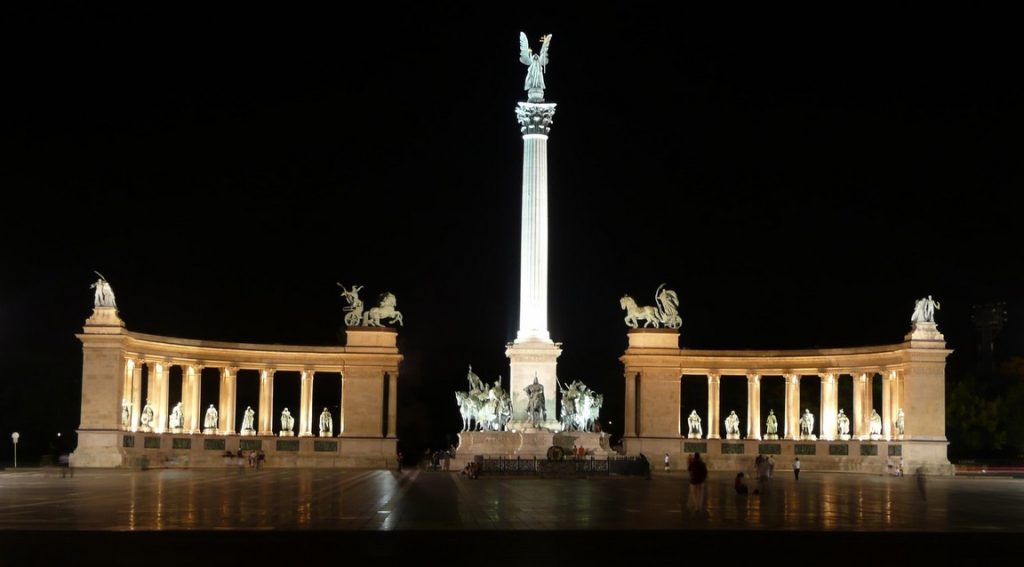Millennium Memorial: Budapest’s Tribute to a Thousand Years
The Millennium Memorial, also known as the Millennium Monument or Millenary Monument, commemorates the thousandth anniversary of the arrival of the seven tribes that founded Hungary in the Carpathian Basin in the 9th century. This significant historical event was celebrated in 1896, and the memorial’s construction began that same year. Although the monument was partly finished in 1900, it wasn’t until later that the surrounding square was named Hősök tere, or Heroes’ Square. The memorial includes statues of the leaders of these seven tribes and other outstanding figures from Hungarian history. During World War II, the monument suffered damage, and in the 1950s, the statues of five Habsburg kings and reliefs depicting Habsburg history were replaced by statues of Hungarian leaders who revolted against the Habsburg rulers.
Monument Highlights
The Cenotaph
At the front of the monument is a large stone cenotaph surrounded by an ornamental iron chain. This cenotaph is dedicated “To the memory of the heroes who gave their lives for the freedom of our people and our national independence.”
The Central Column
The central piece of the memorial is a 36-meter tall column topped by a 5-meter tall statue of Archangel Gabriel, sculpted by Zala György in 1900. Archangel Gabriel, whose name means “God is my strength,” is depicted holding the Holy Crown of St. Stephen (István), the first king of Hungary, in his right hand. The angel holds a two-barred apostolic cross in his left hand, symbolizing St. Stephen’s efforts to convert Hungary to Christianity.
The Seven Chieftains of the Magyars
At the base of the column is a group of seven equestrian statues sculpted by Zala György. These statues represent the seven chieftains of the Magyars, who led their people into the Carpathian Basin in 895 AD. The seven chieftains, according to the Hungarian chronicler Anonymus, author of Gesta Hungarorum, are:
- Árpád (c. 840 – c. 907): The second Grand Prince of the Hungarians, who led his people into the Carpathian Basin. His dynasty ruled Hungary until 1301.
- Előd: Chieftain of the Nyék tribe, which occupied the region around Lake Balaton.
- Kond: Chieftain of a Hungarian tribe in the 9th century.
- Huba: Chieftain of the White Magyars, occupying the region of present-day Győr and Komárom.
- Ond: Chieftain of a Hungarian tribe in the 9th century.
- Tas: Chieftain of the Tarján tribe.
- Tétény (Töhötöm, Tühütüm): Chieftain of a Hungarian tribe.
Statues and Reliefs
The original monument featured sculptures by several artists:
- Zala György: Statues 1-12, 19, and 21; reliefs 13-14, 16-21; originally statues 24 and 26 and reliefs 15, 22-26.
- Füredi Richárd: Statue 15; original statue 25.
- Kiss György: Statue 18.
- Köllő Miklós: Statue 17.
- Margó Ede: Statue 20; original statue 22.
- Senyei Károly: Statues 13 and 16.
- Telcs Ede: Statue 14; original statue 23.
The statues and reliefs replaced in the 1950s were crafted by:
- Antal Károly: Relief 15.
- Grantner Jenő: Statue and relief 24.
- Holló Barnabás: Statue 22.
- Kisfaludi Strobl Zsigmond: Statues and reliefs 25-26.
- Marton László: Relief 22.
- Szabó István: Relief 23.
- Vastagh György: Statue 23.
Visiting the Millennium Memorial
Historical Significance
The Millennium Memorial is not just a collection of statues but a powerful symbol of Hungary’s rich history and cultural heritage. It commemorates the nation’s founding, celebrates its leaders, and honors the memory of those who fought for Hungary’s independence.
Location
The memorial is located in Heroes’ Square (Hősök tere), at one end of Andrássy Avenue, a UNESCO World Heritage site. The square is easily accessible by public transportation, with the nearest metro station being Hősök tere on the M1 line.
Architectural Contributions
The memorial was designed by architect Schickedanz Albert, with contributions from several notable sculptors. The combination of these artistic talents has resulted in a visually stunning and historically significant monument.
Reflecting on Hungary’s Legacy
Visitors to the Millennium Memorial can reflect on Hungary’s thousand-year journey, from the arrival of the Magyars in the Carpathian Basin to the modern-day struggles for independence and democracy. The monument serves as a reminder of the resilience and determination of the Hungarian people.
Conclusion
The Millennium Memorial in Budapest is a must-visit landmark for anyone interested in Hungarian history and culture. Its impressive statues and rich historical context provide a deep and meaningful insight into the nation’s past. Whether you are a history enthusiast, a student of architecture, or simply a curious traveler, the Millennium Memorial offers a profound and memorable experience.

